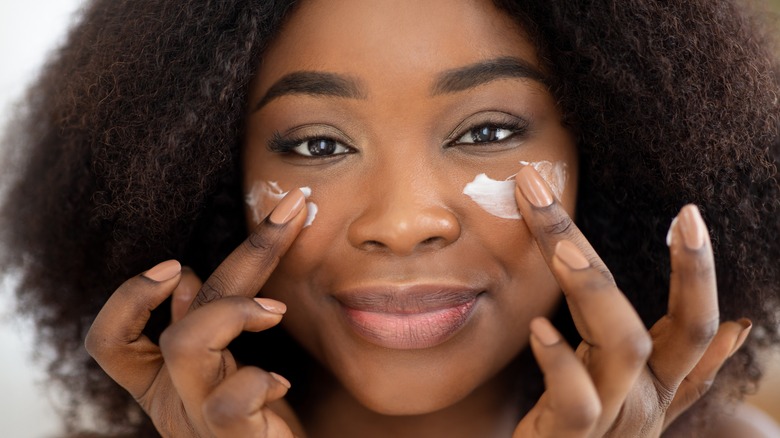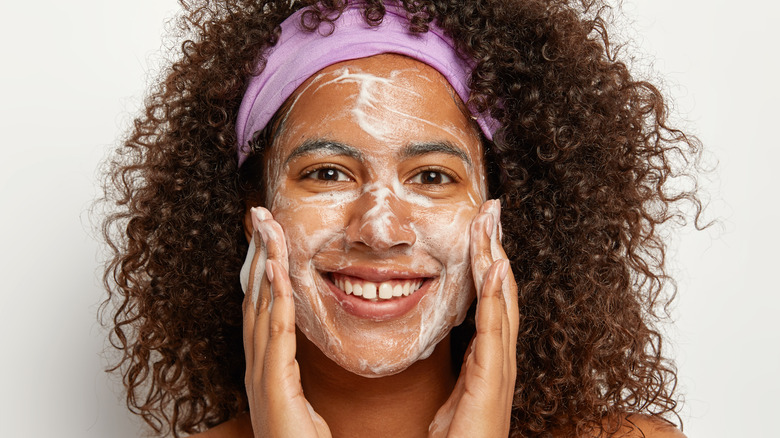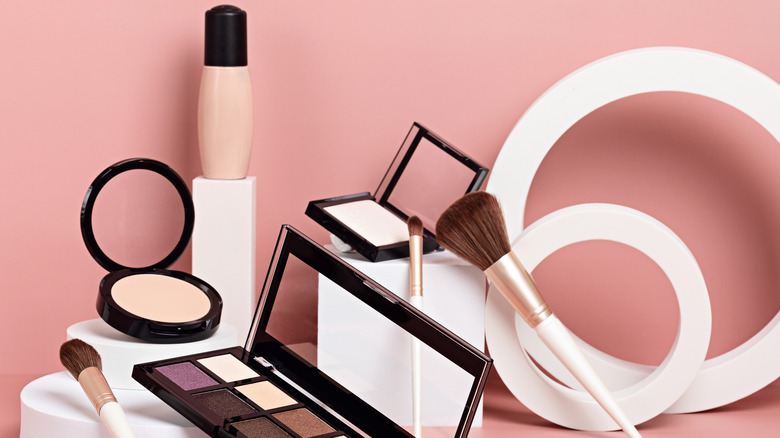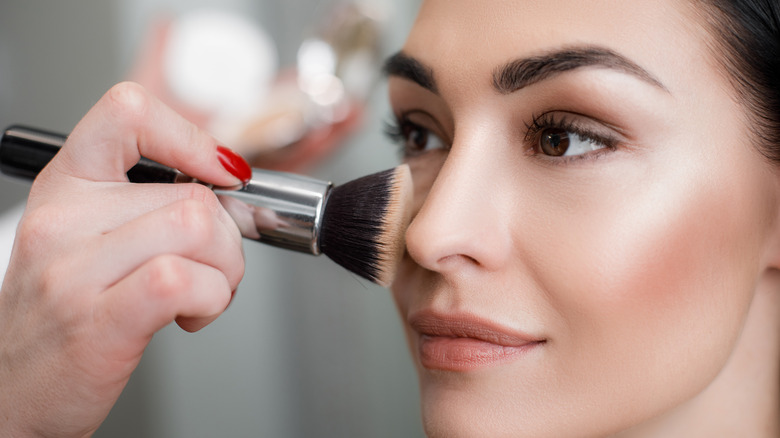Why Your Makeup May Be Looking Patchy And What To Do About It
We may receive a commission on purchases made from links.
Great makeup is generally thought of as skin-like makeup, and unlike what we've been made to believe, it will always be detectable, as both makeup and skin have texture (via Skinn). This is why experienced makeup artists and enthusiasts usually make it their goal to have a more skin-like and less "perfect" finish with their makeup. Where texture is normal and should be embraced more, harsh lines of demarcation, poorly blended makeup, and using a shade of foundation that does not match are not, as they ruin the finish your makeup should have.
Another factor that can ruin your finish is patchiness, or, as some say, cakey makeup. According to De'lanci Beauty, makeup is patchy or cakey when it is uneven, heavy, and too noticeable. Patchy makeup is also flaky and cracks on the skin, causing visible creases and patches. From a lack of hydration to not using the right technique, there are several reasons why you can end up with patchy makeup after your routine. And your skincare could be a major culprit, too.
Prep your skin to avoid patchy makeup
As Huda Beauty says, flawless makeup starts with a great hydrating regime. Any experienced makeup lover knows that makeup always needs a base to grip the skin. Without proper hydration and occlusives, water leaves the skin via trans-epidermal water loss (TEWL). This causes the makeup on top to lie on dry skin and become patchy. Also, the skin's dehydrated state causes it to absorb any water and emollients present in your makeup, leading to patchy and cracking makeup (via LiveGlam). This is why applying a moisturizer before your makeup keeps the skin supple and creates a suitable base for a good finish.
If you have no idea where to start prepping your skin, the Beginners' Guide to Makeup explains that you should cleanse your face first, and then reach for a moisturizer and sunscreen suited to your skin type, even if you have oily skin. Follow this up with a face or eye primer if you're dealing with eyeshadow. Primer creates a smooth base for your makeup by evening out the texture, so it is exactly what you need for a non-patchy finish.
Not exfoliating regularly leads to patchy makeup
Exfoliation involves the removal of dead skin cells through either physical means like coffee or sugar scrubs or chemical exfoliators like body washes and creams with exfoliating acids (via Beautyblender). And again, flawless makeup begins with a great skincare regimen. Not exfoliating regularly leaves dead skin cells and debris on the skin's surface, causing skin to look dull. This reflects in your makeup as dead skin cells can clump up or mix with makeup to become cakey or patchy. Removing dead skin cells makes the skin smoother, allowing your makeup to glide and stay on your skin much easier and for longer.
In addition to giving you radiant skin, exfoliating regularly helps with the texture and absorption of your makeup products. Repêchage explains that exfoliating removes debris from pores which makes them smaller and less noticeable, giving you that poreless, almost-airbrushed effect. And with no junk or debris in the way, your beauty products absorb much better into the skin. Exfoliating has several perks but it's essential that you do not overdo it. Using a gentle chemical exfoliator like the Dermalogica Daily Microfoliant Exfoliator twice a week will improve both your skin health and your makeup looks.
Your makeup products are not compatible
If you've ever placed greasy dishes in a bowl of water with no soap, you'd know that oil and water do not mix. It's the same with your makeup, where products can be oil-based, silicone-based, or water-based. Your makeup can get patchy when you use products made with different types of bases on top of each other, like the greasy dish and water example. As makeup artist Mary Irwin explains to Makeup.com, a silicone- or oil-based product applied under a water-based complexion product will separate your makeup into phases. This separation leads to patchy, flaky, or clumpy makeup. To avoid this, ensure your skincare prep products and makeup have the same base type.
If you're using a silicone-based primer like the cult-favorite Smashbox Photo Finish Foundation Primer, use a silicone-based foundation and concealer like the Maybelline Fit Me Matte + Poreless Foundation. The same goes for oil- and water-based primers and concealers. And if you're having trouble figuring out if your product is silicone or water-based, Healthy Glowy Me says to take a look at the ingredient list. Where silicone-based makeup contains ingredients with the suffix -cone or -siloxane, oil-based products have oils at the top part of their ingredient lists.
Applying makeup with the wrong tools can cause patchy makeup
There's a plethora of application tools in makeup —sponges, puffs, brushes, and fingers— and for good reason. Where puffs are great for touch-ups and brushes contour to perfection, there are scenarios where the result they give for other types of makeup comes out wonky, leading to patchy makeup. One of them is applying full-coverage foundation with brushes and how it causes flaking or cakey-ness of makeup. According to professional makeup artist Marie Poulos, brushing foundation into the skin is bound to leave texture. Too much texture equals a cakey or patchy look (via Adore Beauty).
LiveGlam also suggests that kabuki brushes do not give a smooth finish as using them to buff in full-coverage makeup drags the makeup around the face, leaving streaks and patches. Instead, use a damp sponge, especially when working with liquid foundations as this presses the makeup onto the skin, leaving a flawless finish.
Set your makeup to avoid patches
Think of makeup as a burger of sorts: there's the indispensable hydration your skin needs which forms the base or lower bun. Then, there's your makeup look, which forms the inner part of the said burger. And to top it all off, there's the setting product, which forms the top bun, bringing it all together by keeping your makeup in place and melting it into your skin (via Maybelline).
According to makeup artist Alex Levy, applying a light layer of setting powder on oily or crease-prone areas of the face will prevent your makeup from moving around, sliding off, or being patchy (via Ipsy). Levy also explained that pressing some setting spray on cakey makeup with a soft makeup sponge can bring back the radiance and smoothness to your look. But, it's important to not go overboard with this. According to a tutorial video by Indv Collective, excess setting powder can cause patchiness. Excess setting spray can also dry out the makeup, creating patches. Always apply your setting powder in light layers and dust off the excess to create a smooth, patch-free finish.





